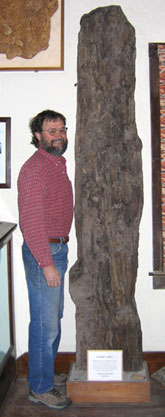
FossilsSwimming Reptiles: Mosasaurs / Plesiosaurs / Turtles Flying Reptiles: Pteranodons Bony Fish: Xiphactinus / Gillicus / Saurodon / Pentanogmius / Pachyrhizodus / Cimolichthys / Apsopelix / Enchodus / Ichthyodectes / Protosphyraena Sharks: Cretoxyrhina / Squalicorax / Ptychodus / Rhinobatos Invertebrates Crinoids: Uintacrinus Clams & Oysters: Inoceramus / Rudistes / Ostrea congesta Cephalopods: Spinaptychus & Rugaptychus / Niobrarateuthis bonneri Birds: Hesperornis / Ichthyornis Other Niobrara fossils: Coprolites / Fossil Tree Other Resources: Geology of Western Kansas / Bonner Fossil Hunters / Oceans of Kansas (off-site) CoprolitesInteresting trace fossils found in the Niobrara Formation are coprolites or petrified animal waste. Coprolites (caw-pro-lites) come in various sizes, shapes and colors and many have pieces of bone and small vertebrae in them. Very large ones are probably from either Xiphactinus fish or mosasaurs. Coprolites that have a definitive spiral shape are from sharks.
Fossil TreeThe Kansas chalk rarely preserves petrified wood. Since the strata is of marine deposition, trees would have had to drift out to sea, waterlog, sink, and be buried in the ocean silt to fossilize. Pieces of petrified wood can be found on the surface of the chalk, but these were transported by glaciation and flooding from the Rocky Mountains during the Pleistocene epoch. Niobrara driftwood must be found in the actual sediment layers of the chalk to verify its true age. It has a more crystalline, porous structure than the flinty, Pleistocene wash wood. ©2015 Keystone Gallery / Photos © Barbara Shelton unless otherwise noted |

